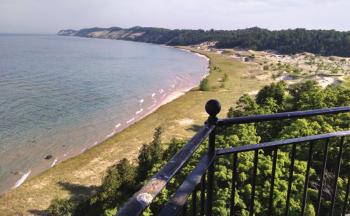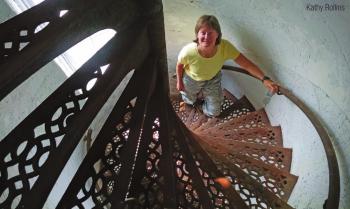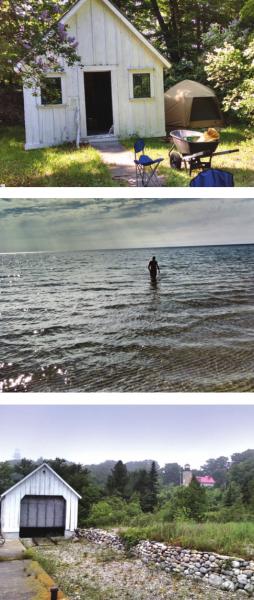Bringing Light Back to the South Fox Island Lighthouse
Group Hopes to Make One of the State’s Least Accessible Parks a Little More Welcoming
March 18, 2016

Bruce Rollins always wanted to be a lighthouse keeper. That romantic and isolated occupation was a dying job even back when he was in high school in the 1960s, though. He became an engineer and eventually retired in Texas.
A year ago, he spotted a two-line classified ad in a boating magazine that read, "camper-keepers wanted."
"He just noted it. He said, "˜This is really interesting; listen to this,’" said Kathy Rollins, Bruce’s wife. "And, of course, I said, "˜You really need to look at that.’"
FIRST KEEPERS IN 56 YEARS

That’s how the Rollins, who had never been to northern Michigan, wound up spending 28 days at the South Fox Island lighthouse last summer. The couple became the lighthouse’s first round-the-clock keepers since 1959, when automation ended the need for someone to live there.
Even though the light itself is no longer necessary (thanks to modern navigation), the Rollins found that there is no shortage of work for lighthouse keepers to perform in that remote locale, 20 miles from the nearest harbor – Northport – over rough Lake Michigan water. They cleared brush, cleaned buildings, mowed grass and gave tours to the occasional visitors who arrived on private boats.
The southern tip of the island was deeded to the state as permanent parkland in 1971. Lack of a natural harbor makes the island hard to reach, however, which makes the park on South Fox Island one of the state’s most remote and least visited places.
Two-thirds of the island is private after a controversial land swap between the state and real estate developer David Johnson was completed in 2003.
"I DON’T WANT TO DROWN"
Rollins said they knew there was risk in getting dropped off at such a remote location, far from comforts like refrigerated food and medical care, so the couple got their affairs in order.

"We’re both in very, very good health, although we’re both in our 60s," Rollins said.
"And so, yes, we’d take double of all the prescriptions we’d need. I did update our wills.
We really talked through, you know, "˜Yeah. That’d be a fun way to go if we had a heart attack or a serious health emergency. It happens to everybody some time.’" Perhaps their biggest challenge would be getting to the island. The only way to reach South Fox is by private boat. There is an airstrip, but it’s owned by Johnson and isn’t an option for lighthouse volunteers.
"I’m totally a land lubber. I’m from Colorado, Wyoming. I don't do water," Rollins said. "And it looked really like a total impossibility to me. And so we really kind of made an effort to suspend disbelief and assume it was something we could work out."
Their private ferry captain, Northport’s Phil von Voigtlander, skippered a boat just big enough to carry four people and gear. That didn’t do much to placate Rollins’ thalassophobia.
"I was terrified. Even a big boat would have terrified me," she said. "And my husband took it in stride very much. You know, "˜It’s totally safe. Phil’s very, very conservative in his review of weather and his strategy for going out,’ so I just had to trust that Bruce wouldn’t get me into some trouble. I don’t want to drown. I don’t mind dying, but I don’t want to drown."
AN OTHERWORLDLY PLACE
An out-of-body experience is what made this adventure possible, sparking the creation of the Fox Island Lighthouse Association (FILA), the nonprofit group dedicated to restoring the lighthouse complex and making it accessible to visitors.
Catherine Allchin got the idea in 2000 after she took a summer off from a freelance career to work on a charter boat.
"A gentleman hired us to bring him and his son out to the island to spread his brother’s ashes," Allchin said. "It turns out the man was Zane Bourisseau, the grandson of Lewis Bourisseau, who was the first Native American light keeper."
For the Suttons Bay resident, visiting South Fox for the first time was transformative.
"I had never been out there and we spread his ashes and we walked around and he was talking about growing up there as a kid," Allchin said.
She said that, as she walked around the overgrown and abandoned property and took in the stunning scenic beauty, she was taken back to a time when families lived at the station and operated the lighthouse.
"I’m standing on the shore facing west, looking out, and it was a beautiful blue sky, calm water day," Allchin said, "but all of a sudden, I had this flash and I wasn’t myself. I was this 9-year-old little girl and I could tell you what my clothes looked like. And I was looking out, not on a clear sky and calm waters, but on a black wall of clouds that was coming across, and the wind was blowing and the waves were crashing. It was just an amazing experience and I felt the whole thing."
The charter captain interrupted her reverie; it was time to leave South Fox, but Allchin said from that day forward she’s been dedicated to returning to the island. When she got back to the mainland, she placed an ad in the Leelanau Enterprise looking for others interested in forming a group to restore the lighthouse.
LOTS OF WORK AND CANNED FOOD

Von Voigtlander dropped the Rollins unceremoniously on Fox Island last summer; they were shown around, learned where tools were stored and told what needed to be trimmed and what maintenance had to be performed.
They all had lunch and von Voigtlander got back in his boat and returned to Northport. The building’s accommodations – keeper’s quarters in the original lighthouse and a separate assistant keeper’s quarters – are not habitable. Allchin estimates it will be a decade before people will be able to stay in those buildings because lead paint needs to be removed and the structural restoration would be challenging even if the buildings were located on the mainland.
The Rollins stayed in a tent. They brought solar panels to keep their cell phones and a laptop charged. Faint cell service was available, best from the top of the lighthouse in overcast weather.
"I took a lot of canned food – a lot of tuna, a lot of canned chicken, a lot of vegetables. And we did take onions, carrots, cabbage, you know, until they rotted, and a lot of peanut butter," Rollins said. "And we ate well. My husband lost a little weight, but I did not. And we got tired of canned chicken and beans."
Their days went like this: wake up, eat breakfast, work for several hours, eat lunch, take a walk, work for a couple more hours, swim and wash up, make dinner, go to bed.
"We slept until we got up and it was warm enough to get out of the tent," she said. "It was a really chilly summer."
When it was windy and visitors in private boats were unlikely to arrive, they explored the public sections of the island, walking up the shore to the north, taking in the pristine steep sand bluffs on the island’s western face.
VISITORS FROM NEAR AND FAR
During their stay, six private boats landed. The Rollins gave the visitors tours of the compound. They offered insight into what life was like for lighthouse keepers a hundred years ago.
"Normally when people pull up on the island they can eat a picnic on the location, but they can’t see the buildings. We got to take people through the buildings, which was really great," Rollins said. "One couple said that they had read about us on Facebook, and they came up and it was really fun."
Even a group from the Johnson compound showed up for a tour. Rollins believed it was a couple employees and their families who walked along the beach down the eastern side of the island to the lighthouse.
"They wanted to see the buildings, which was really fun, to visit with them, show them the property and interact," Rollins said.
They saw regular activity from the Johnson property through their stay, but had little interaction.
"We saw their boat come and go several times and we saw their plane several times," she said.
They saw a kayaker who appeared to be circumnavigating the island.
Allchin said there is no relationship between FILA and Johnson.
"We have no communication. We’ve tried to contact him. We’re always referred to his business manager," she said. "It’s not a bad relationship. I know that his crews have helped us when we’ve needed to land or bring materials out there."
BITTESWEET FAREWELL
Frequent FILA volunteer work trips to the island over the past decade have proven that transport to and from South Fox doesn’t come on a precise schedule.
"We went for three days – and it was seven days by the time we got picked up," due to rough conditions on Lake Michigan, Allchin recalled of one visit. "Fortunately, I was in charge of food. Coming from a large family, I always prepare."
Allchin said those work trips take a lot of planning. They’ve got to identify a task, assemble everything needed to accomplish it and get everything to the island.
"It’s not like you can go down to the hardware store to get something that you forgot," Allchin said.
Rollins knew they might not leave on the day they planned.
"We had been prepared to be there a month, and about three and a half weeks in we did start saying, you know, "˜Be ready for a weather window to pull us off,’ and we were actually on the island for exactly 28 days when the weather window did come," Rollins said.
When von Voigtlander returned, the Rollins had mixed feelings.
"You know, I was terribly relieved, but I was also sad. I was ready to drink a beer and eat some ice cream," Rollins said, "but we had a good time. We really did."
SAFE HARBOR NEEDED
What keeps the South Fox Island lighthouse from being a park most people can visit is the lack of a safe harbor. The construction of a dock and a break wall to protect it is one of FILA’s priorities, Allchin said. The group’s been working with the Department of Natural Resources, (DNR) since 2010 to achieve that goal, but it’s slow going. Studies need to be performed to determine what will work, plans need to be drawn up and funds need to be approved.
"We have been told that they have a cap right now of half a million dollars to build a structure out there," Allchin said. "Back in 2010, when we first approached this, we had three different scenarios for building a harbor out there and the least expensive was $3 million."
Allchin said, once a harbor is constructed, it should become much easier to visit.
She said there is already interest among the operators of ferries to Beaver Island and the Manitou islands to offer service to South Fox.
FILA also hopes to restore each structure in the complex so the station can serve as a window into what life was like at a Great Lakes lighthouse.
"We have preliminary drawings of making the whole compound self-sufficient with solar energy and retaining water and everything else," she said.
Allchin vows she won’t give up until her dreams come true, but she said it’s likely to take another decade to achieve FILA’s goals.
The Foxes
Treasure, Tragedy and Dreams
1867 – Congress allots $18,000 for the construction of a lighthouse on South Fox Island.
1876 – A lighthouse keeper learns of a shipwreck involving a sailor hired to commit a murder. The sailor, the story goes, buried as much as $35,000 in dishpans next to a tree with a nail driven into its trunk.
1905 – The Traverse City Evening Record reports a long-rumored treasure of as much as $150,000 in Spanish gold buried on North Fox.
1959 – The light is made automatic, eliminating the need for a light keeper.
1968 – Modern navigation renders the light unnecessary.
1971 – The U.S. Department of Interior transfers the southernmost 115 acres to Michigan for use as a public park "in perpetuity."
1976 – The owner of North Fox uses the island’s remoteness to make child pornography. Once uncovered, he fled to Europe where he died 20 years later.
1978 – South Fox is purchased through a series of complicated financial arrangements that concealed the owner’s identity. As the conspiracy unravels, it emerges that South Fox was purchased with laundered drug money.
1983 – Six men die when a U.S. Army Chinook helicopter crashes on South Fox and bursts into flames. The helicopter was practicing nighttime overwater navigation on the southeastern side of the island when it crashed into a wooded hillside.
1989 – David Johnson buys large sections of South Fox. He would go on to develop part of the island as a family retreat and improve the island’s airstrip.
1994 – Johnson purchases North Fox.
2003 – After years of debate and controversy, Michigan approves a land swap that consolidates Johnson’s ownership of most of South Fox in exchange for North Fox Island. The lighthouse property and a section on the western coast and northern portion of the island remain public. The state owns 1,200 acres or approximately 35 percent of the island.
2006 – The Fox Island Lighthouse Association becomes a nonprofit; the group is able to make annual trips to begin restoration and maintenance. A donated boat, the Lightkeeper, is launched in August.
2011 –The Lightkeeper is determined too expensive to keep seaworthy due to cost of repairs and fuel. FILA begins to rely on private boats for trips to the island.
2015 – The first long-term residents of the station since 1959 arrive and stay 28 days, camping at the station. Bullard, Tex., residents Kathy and Bruce Rollins hope to return for a stay at the lighthouse in the summer of 2016.
Sources: Fox Island Lighthouse Association’s website; "The Fox Islands North and South" by Kathleen Craker Firestone
Trending

Springtime Jazz with NMC
Award-winning vibraphonist Jim Cooper has been playing the vibraphone for over 45 years and has performed with jazz artist... Read More >>
Dark Skies and Bright Stars
You may know Emmet County is home to Headlands International Dark Sky Park, where uninterrupted Lake Michigan shoreline is... Read More >>
Community Impact Market
No need to drive through the orange barrels this weekend: Many of your favorite businesses from Traverse City’s majo... Read More >>


